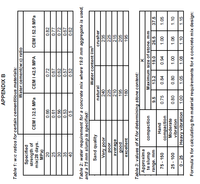
Structural Analysis
6th Edition
ISBN: 9781337630931
Author: KASSIMALI, Aslam.
Publisher: Cengage,
expand_more
expand_more
format_list_bulleted
Concept explainers
Question

Transcribed Image Text:Refer to Appendix A for tables and equations to be used. Use the CNCI method.
water requirementinliters
w:c ratio
• Cement content (kg/m of concrete) =
• Mat = CBD (K – 0.1 FM)
You are given the following design parameters for a concrete mix:
M.
M.
D.
• Vols = 1000 -
The compressive strength of the concrete mix must be 40 MPa after 28 days. The cement
that is going to be used is a CEM I 52.5 with a relative density of 3.14. The stone available
Taps vis % water
30
is a 19.0 mm stone with a dry compacted bulk density (CBD) of 1780 kg/m3 and a relative
density of 2.24. An average, natural sand with a fineness modulus of 2.45 and a relative
25
20
density of 2.86 is going to be used for the mix. The slump on site is specified as 75 mm.
15
The concrete is going to be compacted by moderate vibration on site.
10
5
Calculate and show the amount of water, cement, stone and sand that is needed to make
10
15
20
Тарв
up 1 m3 of concrete mix as specified above.

Transcribed Image Text:APPENDIX B
Table 1: w:c ratios for certain cementitious materials:
Water:cement(w:c) ratio
Specified
strength of
mix(28 days.
MPa)
CEM I 32.5 MPa
CEM I 42.5 MPA
CEM I 52.5 MPa
99'0
0.61
0.72
0.82
25
0.67
0.77
0.72
0.67
0.62
35
0.53
0.57
0.5
0.52
0.62
Table 2: water requirement for a concrete mix where 19.0 mm aggregate is used,
and a 75 mm slump is specified:
Water content I/m3
Sand quality
natural
crusher
Very poor
235
240
poor
225
225
average
210
215
205
poob
excellent
195
180
195
Table 3: values of K for determining stone content:
Approxima
te slump
K.
Maximum size of stone. mm
compaction
range. mm
9.5
13.2
19.0
26.5
37.5
Hand
75 - 150
0.75
0.84
0.94
1.05
compaction
Moderate
00'L
00'L
80'L
1.10
25 - 100
0.80
0.80
1.10
vibration
90'L
0 - 25
Heavy vibration
00'L
1.05
1.15
Formula's for calculating the material requirements for a concrete mix design:
Expert Solution
This question has been solved!
Explore an expertly crafted, step-by-step solution for a thorough understanding of key concepts.
Step by stepSolved in 3 steps with 2 images

Knowledge Booster
Learn more about
Need a deep-dive on the concept behind this application? Look no further. Learn more about this topic, civil-engineering and related others by exploring similar questions and additional content below.Similar questions
- Note:hand written solution should be avoided.arrow_forwardOne cubic yard of fresh concrete mix includes 1900 lbs coarse and 1150 lbs fine aggregates. Water-cement ratio (W/C) for the mix is 0.5. Given information: Concrete weight = 150 pcf Weight of standard cement bags 94 lbs Water weight = 8.34 pounds per gallon Approximately how many bags of Portland cement should be added to each cubic yard of this mix? 4 bags 5 bags 6 bags 7 bagsarrow_forwardWorking on major construction project that requires considerable amounts of concrete to be used,you are asked to design a concrete mix following the BRE methodology. All the necessary tables forthis can be found in the Appendix. The concrete mix specifications are:o Characteristic compressive strength of 35 N/mm 2 at 28 days.o Failure rate of 2%o Previous control data yielded a standard deviation of 10 N/mm 2o CEM-I 42.5o Air-entraining is not requiredo Maximum water to cement ratio 0.40o Minimum cement content 390 kg/m 3o Required slump 50 mmo Coarse aggregate: Crushed maximum size 20mmo Fine aggregate: Uncrushed with 90% passing 600 μm sieveo Relative density of aggregates: 2.5o Coarse aggregate has 4% moistureo Fine aggregate is dry and has 1.2% absorption.o Volume of the required trial mix: 0.090 m 3Following the BRE step-by-step process estimate the water content of the mix estimate the content of aggregates, provide the estimated mix quantitiesarrow_forward
- I need answer within 20 minutes please please with my best wishesarrow_forwardWorking on major construction project that requires considerable amounts of concrete to be used,you are asked to design a concrete mix following the BRE methodology. The concrete mixspecifications are:o Characteristic compressive strength of 50 N/mm 2 at 7 days.o Failure rate of 2%o Previous control data yielded a standard deviation of 5 N/mm 2o CEM-I 52.5o Air-entraining is not requiredo Required slump 120 mmo Coarse aggregate: Crushed maximum size 10mmo Fine aggregate: Uncrushed with 45% passing 600 μm sieveo Relative density of aggregates: 2.7o Coarse aggregate has 4% moistureo Fine aggregate is dry and has 1.2% absorption.o Volume of the required trial mix: 0.120 m3 Create the mix design and state what actions and recommenations you would do if trial produced a result with a mean compressive strength of 64 MPa at 7 days and the slump was 80mm.arrow_forward
arrow_back_ios
arrow_forward_ios
Recommended textbooks for you

 Structural Analysis (10th Edition)Civil EngineeringISBN:9780134610672Author:Russell C. HibbelerPublisher:PEARSON
Structural Analysis (10th Edition)Civil EngineeringISBN:9780134610672Author:Russell C. HibbelerPublisher:PEARSON Principles of Foundation Engineering (MindTap Cou...Civil EngineeringISBN:9781337705028Author:Braja M. Das, Nagaratnam SivakuganPublisher:Cengage Learning
Principles of Foundation Engineering (MindTap Cou...Civil EngineeringISBN:9781337705028Author:Braja M. Das, Nagaratnam SivakuganPublisher:Cengage Learning Fundamentals of Structural AnalysisCivil EngineeringISBN:9780073398006Author:Kenneth M. Leet Emeritus, Chia-Ming Uang, Joel LanningPublisher:McGraw-Hill Education
Fundamentals of Structural AnalysisCivil EngineeringISBN:9780073398006Author:Kenneth M. Leet Emeritus, Chia-Ming Uang, Joel LanningPublisher:McGraw-Hill Education
 Traffic and Highway EngineeringCivil EngineeringISBN:9781305156241Author:Garber, Nicholas J.Publisher:Cengage Learning
Traffic and Highway EngineeringCivil EngineeringISBN:9781305156241Author:Garber, Nicholas J.Publisher:Cengage Learning


Structural Analysis (10th Edition)
Civil Engineering
ISBN:9780134610672
Author:Russell C. Hibbeler
Publisher:PEARSON

Principles of Foundation Engineering (MindTap Cou...
Civil Engineering
ISBN:9781337705028
Author:Braja M. Das, Nagaratnam Sivakugan
Publisher:Cengage Learning

Fundamentals of Structural Analysis
Civil Engineering
ISBN:9780073398006
Author:Kenneth M. Leet Emeritus, Chia-Ming Uang, Joel Lanning
Publisher:McGraw-Hill Education


Traffic and Highway Engineering
Civil Engineering
ISBN:9781305156241
Author:Garber, Nicholas J.
Publisher:Cengage Learning